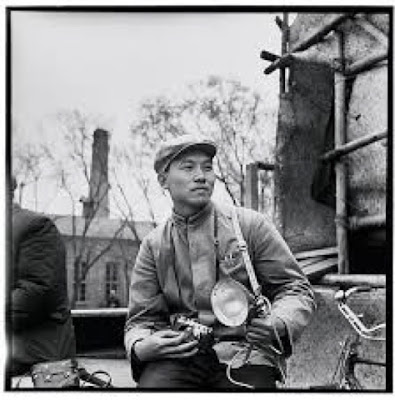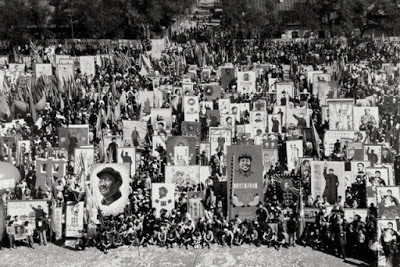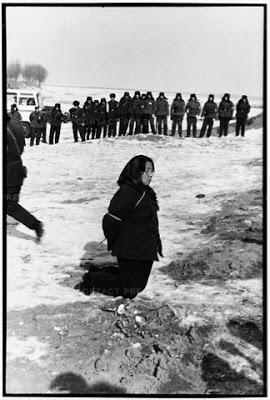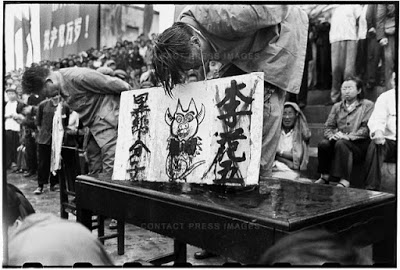Social Sciences

Several earlier posts have highlighted how challenging it is to come to firm conclusions about some of the most basic facts about the history of the Cultural Revolution in China (link, link, link, link). The history of this important recent period of Chinese history is still a work in progress.



Several things shout out from the photos in this volume that perhaps shed light on the experience for Chinese people of the Cultural Revolution. One is the intensity, size, and rage of the crowds that are depicted. It is perhaps extreme to say this, but many of these photos evoke mass madness -- people caught up in the emotions and hatreds of the period in ways that obliterated their ordinary human impulses of pity and kindness. What we see instead is a sea of human faces, taking in the humiliation and abuse of their neighbors, while shouting support or laughing at shaming self-confessions, dunce caps, and raw physical abuse.
Related to this is the cruelty that the photos depict. There is no pity shown for the victims forced to humiliate themselves, who are physically tormented, and who were sometimes killed. What is portrayed is a merciless public scapegoating of people, often for the most trivial or spurious of reasons. People were accused of belonging to one of the "four elements" -- landlords, rich peasants, counter-revolutionaries, or "bad characters" (55), and they were dealt with summarily. Physical violence was common; but so too was a deep and sustained imposition of shaming on the hapless school teacher, local party official, or slightly better-off peasant. Li describes the scene of the execution of seven men and one woman, two of whom were "counter-revolutionaries" because of a flyer they had published titled "Looking North". The scene of the execution troubled Li for many years. "All eight were put on the backs of trucks in pairs, driven through town, then out to the countryside northwest of Harbin. There, on the barren grounds of the Huang Shan Cemetery, they were lined up, hands tied behind their backs, and forced to kneel. They were all shot in the back of the head" (139). The sequence of photos Li took of this execution are harrowing. The final photos of the volume depict the execution of Wang Shouxin, a former Party branch secretary, on charges of embezzlement, in 1980 (after the end of the Cultural Revolution). Li Zhensheng was present for this killing as well. (The woman kneeling in the photo above is Wang.)
- Was The Civil Rights Movement A Revolution?
photo: African-American newsman attacked by mob in Little Rock, 1957 (link) I think of the results of the civil rights struggles of the 1950s and 1960s in the United States as the second American revolution, though a slow-moving one. And it is tempting...
- Granular Perspectives On The Cultural Revolution
It has been observed in earlier posts that there is still a lot we do not understand about China's Cultural Revolution (post, post, post). Why such a sudden and apparently crazed eruption of violence? Why such ultra-radicalism among extremely young...
- Turning Points In History?
We often think that the histories of nations or peoples take turning points. A series of events occur that could have gone either way, things went badly rather than well, and the future development of this people is forever changed. It is on a different...
- Skocpol On The 1979 Revolution In Iran
An earlier post reviewed Theda Skocpol's effort in States and Social Revolutions: A Comparative Analysis of France, Russia and China to provide a comparative, structural account of the occurrence of social revolutions. There I suggested that the...
- Skocpol On The Chinese Revolution
(Sources: States and Social Revolutions, pp. 155, 282) In States and Social Revolutions: A Comparative Analysis of France, Russia and China (1979) Theda Skocpol set out to discover a causal analysis of the occurrence of social revolution,...
Social Sciences
The Cultural Revolution through photography

image: Li Zhensheng, self portrait
Several earlier posts have highlighted how challenging it is to come to firm conclusions about some of the most basic facts about the history of the Cultural Revolution in China (link, link, link, link). The history of this important recent period of Chinese history is still a work in progress.
A genuinely remarkable book of documentary photography on this history appeared in 2003, with the title Red-Color News Soldier. Chinese historian Jonathan Spence provides an illuminating introduction to the volume and the period. The core of the book, edited and presented by Robert Pledge, is a body of photography by Li Zhensheng. Li was a rank-and-file news photographer in Heilongjiang in the northeast of China who had received film training in the 1960s. Li provides a short but fascinating autobiographical statement of his early years during the Great Leap Forward, and he adds to this narrative in each of the main sections of the book. Li took thousands of photographs during the early years of the Cultural revolution, some of which he knew to be politically dangerous. He therefore succeeded in hiding thousands of these negatives for thirty-five years, before making them available for publication in 2003.
The book provides genuinely new emotional insight into this period of chaos in China's recent history. The photographs capture the passions of committed Red Guards as well as the pathos of the often innocent scapegoats who were the victim of Red Guard violence. Mass emotion and individual pathos are captured in almost all the images in the book.
The book provides genuinely new emotional insight into this period of chaos in China's recent history. The photographs capture the passions of committed Red Guards as well as the pathos of the often innocent scapegoats who were the victim of Red Guard violence. Mass emotion and individual pathos are captured in almost all the images in the book.



Related to this is the cruelty that the photos depict. There is no pity shown for the victims forced to humiliate themselves, who are physically tormented, and who were sometimes killed. What is portrayed is a merciless public scapegoating of people, often for the most trivial or spurious of reasons. People were accused of belonging to one of the "four elements" -- landlords, rich peasants, counter-revolutionaries, or "bad characters" (55), and they were dealt with summarily. Physical violence was common; but so too was a deep and sustained imposition of shaming on the hapless school teacher, local party official, or slightly better-off peasant. Li describes the scene of the execution of seven men and one woman, two of whom were "counter-revolutionaries" because of a flyer they had published titled "Looking North". The scene of the execution troubled Li for many years. "All eight were put on the backs of trucks in pairs, driven through town, then out to the countryside northwest of Harbin. There, on the barren grounds of the Huang Shan Cemetery, they were lined up, hands tied behind their backs, and forced to kneel. They were all shot in the back of the head" (139). The sequence of photos Li took of this execution are harrowing. The final photos of the volume depict the execution of Wang Shouxin, a former Party branch secretary, on charges of embezzlement, in 1980 (after the end of the Cultural Revolution). Li Zhensheng was present for this killing as well. (The woman kneeling in the photo above is Wang.)
Another striking feature is the cult of Mao that many of the photos demonstrate. "By the fall of 1966 Mao had become, to most Chinese, a living god" (144). Portraits of the Chairman and peasants shaking their Little Red Books abound at these mass meetings. A headline in the Heilongjiang Daily in 1966 shouts its praise: "Long life to Chairman Mao, Great Leader, Great Commander in Chief, Great Helmsman" (71). This is the very same great helmsman who led China into the Great Leap Forward and a devastating famine resulting in more than 20 million deaths, only eight years earlier. Mao publicly greeted over 11 million Red Guards in Tiananmen Square in appearances over the first several years of the Cultural Revolution, according to Li (131). The many images of Mao in these news photos were not accidental; news editors made sure that there were ample posters in the published photo, even if they were not visible in the original scene:
Another time I made a picture of a crowded rally at a sports field from behind, so you couldn't see all the portraits held up, only their wooden frames -- and for the final image, my editor instructed me to add pictures of Mao to the back of the frames, even though this skewed the perspective and it made no sense that they were facing the wrong way. (133)
So the book provides a rich canvas through which we can begin to grasp some of the human meaning of the experience of the Cultural Revolution. It is important to be clear about the limits of the book, however. It is geographically limited to the extreme northeast of China, the province of Heilongjiang. So it is suggestive of the nature of the experience in other places -- but only suggestive. It would be striking to have other images from Souzhou, Wuhan, or Xian; how similar or different were the currents of rage and violence in those other parts of China?
Second, the book does not shed light on the causes or dynamics of the Cultural Revolution. Li refers to the politics of rival factions on several occasions, but we don't get much of an idea of what the shouting was about in those struggles. And there is no basis for drawing inferences about the leadership's intentions and strategies on the basis of this collection. Li's perspective is from the street: these are the demonstrations that occurred, this is how the crowds looked, here are some of the acts of humiliation and violence that occurred in my presence. It is for others to set the stage by uncovering the political dynamics of the Cultural Revolution from beginning to end.
But the questions raised by this volume are enormously important. Li's camera depicts a population gone mad; and yet these were ordinary people just like the citizens of Albany or Albuquerque or Peoria. So we are forced to ask, what are the conditions that make a populace ready for this kind of raging cruelty; and what are the sparks that unleash the outbreak of a period like the Cultural Revolution?
- Was The Civil Rights Movement A Revolution?
photo: African-American newsman attacked by mob in Little Rock, 1957 (link) I think of the results of the civil rights struggles of the 1950s and 1960s in the United States as the second American revolution, though a slow-moving one. And it is tempting...
- Granular Perspectives On The Cultural Revolution
It has been observed in earlier posts that there is still a lot we do not understand about China's Cultural Revolution (post, post, post). Why such a sudden and apparently crazed eruption of violence? Why such ultra-radicalism among extremely young...
- Turning Points In History?
We often think that the histories of nations or peoples take turning points. A series of events occur that could have gone either way, things went badly rather than well, and the future development of this people is forever changed. It is on a different...
- Skocpol On The 1979 Revolution In Iran
An earlier post reviewed Theda Skocpol's effort in States and Social Revolutions: A Comparative Analysis of France, Russia and China to provide a comparative, structural account of the occurrence of social revolutions. There I suggested that the...
- Skocpol On The Chinese Revolution
(Sources: States and Social Revolutions, pp. 155, 282) In States and Social Revolutions: A Comparative Analysis of France, Russia and China (1979) Theda Skocpol set out to discover a causal analysis of the occurrence of social revolution,...
